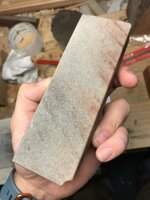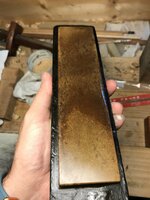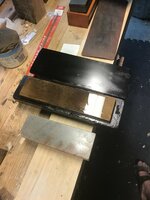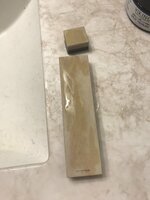If you guys are doing a fully natural progression, what's your favorite stone to use to set the bevel?
You are using an out of date browser. It may not display this or other websites correctly.
You should upgrade or use an alternative browser.
You should upgrade or use an alternative browser.
Natural bevel setter
- Thread starter Friedramen
- Start date
I've tried a lot. Nothing really is any good. Best bet is likely in the soft sandstone range. There are some Middle america Sandstones, Dalmore Yellow, Queer creek... truth is nothing works fast without significant pressure (where good low-mid grit naturals shine)... and significant pressure when beveling tends to be prone to creating hooks, frowns, or other problems with razors because of flex that isn't there with most tools. It's do-able with a lot of stuff... but expect to spend ballpark 5-10x as long as you would with a synthetic.
I’ve got one particular Washita 6x2 and one red la dressante Coticule 6x1.5 that both have ludicrous speed compared to other naturals. I’ve got a Queer creek 8x2 also with one side lapped smooth and the other left rougher and that Can cover a pretty wide range too.
The value of a natural bevel setter is debatable to some people, but I find mine super valuable. For me a synthetic bevel setter is a fixed grit with particles engineered for maximum cutting action, while naturals are a lot more flexible and cover a much larger range of finished edge qualities.
If you’re running Gold Dollars or warped blades you’ll want a serious synthetic bevel setter or diamond plate. I don’t dabble in wonky crap blades, and I find most ebay vintage Americans I buy can be bevel set on naturals in <15mins.
Where I love my naturals is for touch up honing, I can do a handful of laps on Washita s or aggressive Coticules as a pre-finisher and end up with a 100% reset blade with no visible wear. One of my favorite edges is a 100% Arkansas progression coarse Washita->fine Washita->surgical black. No synthetic edge I’ve found comes close to that progression, but if one did it would sure involve more than just 3 stones. I could easily cut it down to 2 stones too and just do more laps finishing.
The value of a natural bevel setter is debatable to some people, but I find mine super valuable. For me a synthetic bevel setter is a fixed grit with particles engineered for maximum cutting action, while naturals are a lot more flexible and cover a much larger range of finished edge qualities.
If you’re running Gold Dollars or warped blades you’ll want a serious synthetic bevel setter or diamond plate. I don’t dabble in wonky crap blades, and I find most ebay vintage Americans I buy can be bevel set on naturals in <15mins.
Where I love my naturals is for touch up honing, I can do a handful of laps on Washita s or aggressive Coticules as a pre-finisher and end up with a 100% reset blade with no visible wear. One of my favorite edges is a 100% Arkansas progression coarse Washita->fine Washita->surgical black. No synthetic edge I’ve found comes close to that progression, but if one did it would sure involve more than just 3 stones. I could easily cut it down to 2 stones too and just do more laps finishing.
Last edited:
If you have the right striped iyoto jnat it will get it done... A ridiculously fast coticule can do it but I always found bevels set on coticules wanting.
If you have the right striped iyoto jnat it will get it done... A ridiculously fast coticule can do it but I always found bevels set on coticules wanting.
Yeah I get more consistent results just finishing on Coticules vs trying a full bevel set to finish. The LD is crazy fast though so it’s just too tempting for touch ups!
Slash McCoy
I freehand dog rockets
If I was wanting a natural bevel setter, it would be an Arky, not too hard, nice and big.
Bevel set on an off blade would be a serious chore with a natural. On a shaving blade it's a piece of cake. You could use a finisher to do that. I've used 2 different striped iyoto and an ikarashi. Both work. But I haven't used them in years. If your looking to do it old school I get it. But you won't gain anything doing it that way. Meaning a bevel is a bevel is a bevel.
I guess the real question here is probably what’s OPs motivation for asking, and if we’re actually debating going to a full natural progression it might help to know what type of razors you use if there’s a trend in your razor preferences. Different steel tempering styles developed regionally based on available ores and available sharpening stones, so using an Arkansas stone progression on a rock hard Tanifuji blade might be a full day commitment.
I use a piece of marble (natural stone) with a strip of lapping film on top of it 
Jokes aside, I haven't been successful with coticules or arks for this task.
Jokes aside, I haven't been successful with coticules or arks for this task.
Chandu
I Waxed The Badger.
One of my favorite edges is a 100% Arkansas progression coarse Washita->fine Washita->surgical black. No synthetic edge I’ve found comes close to that progression, but if one did it would sure involve more than just 3 stones. I could easily cut it down to 2 stones too and just do more laps finishing.
there is a lot to be said for and in many cases a lack of appreciation for the lack of uniformity in grit sizes that natural stones provide.
there is a lot to be said for and in many cases a lack of appreciation for the lack of uniformity in grit sizes that natural stones provide.
You’re definitely right! They just respond so much more to varying pressure and technique than synthetics do. Most natural “bevel setters” can actually finish with a better edge than a 3mu alundum particle synthetic if you know what you’re doing. They cut slowly, but when you consider the range of cutting action you can cover on one stone it’s not really any added time unless your blade is wonky. It takes some effort to master some stones, but there’s a lot more benefit to naturals than just trying to do things like grandpa did.
I like a Washita no. 1 used with oil as a natural bevel-setter, followed by a translucent or black hard Arkansas. Of the sand-stones, one that's worked for me has been a Pike "Lake Superior" stone. Not so much luck with the Queer Creek or Dalmore blue for grunt work from my end. Maybe I need to lap these far more coarsely.
kelbro
Alfred Spatchcock
I like a Washita no. 1 used with oil as a natural bevel-setter, followed by a translucent or black hard Arkansas.
All that a person really needs for a smooth shave
Well, also a strop!
A bevel is formed when an edge meets in the middle. An apex. How is one apex better than another? Imo it doesnt matter what you use.
Different stones and cutting actions yield different bevel geometries particularly at the apex. The end result is you need more or less time refining on different slower cutting finishers to get the final edge behavior you want. It ends up being overall faster for me to match up certain coarse/midrange stones with certain finishers.
An edge off a Washita for me takes fewer laps to finish on a slow cutting hard Arkansas than required to finish an edge coming off 3mu synthetic. The Washita also cuts noticeably faster with a little pressure than the 3mu, and stays flat.
It sounds like I’m blurring the question away from bevel setters into midrange, but I’m really not- I’ve got no shortage of midrange options and my experience is the Washita does it all if the blade isn’t particularly hard tempered. It’s just an easy brain dead decision to start with the Washita when I want an ark finished edge.
The other natural bevel setters have some value, but I don’t find them as useful and flexible as washitas.
A Washita edge on a kitchen knife is pretty wicked too.
kelbro
Alfred Spatchcock
Different stones and cutting actions yield different bevel geometries particularly at the apex. The end result is you need more or less time refining on different slower cutting finishers to get the final edge behavior you want. It ends up being overall faster for me to match up certain coarse/midrange stones with certain finishers.
An edge off a Washita for me takes fewer laps to finish on a slow cutting hard Arkansas than required to finish an edge coming off 3mu synthetic. The Washita also cuts noticeably faster with a little pressure than the 3mu, and stays flat.
It sounds like I’m blurring the question away from bevel setters into midrange, but I’m really not- I’ve got no shortage of midrange options and my experience is the Washita does it all if the blade isn’t particularly hard tempered. It’s just an easy brain dead decision to start with the Washita when I want an ark finished edge.
The other natural bevel setters have some value, but I don’t find them as useful and flexible as washitas.
A Washita edge on a kitchen knife is pretty wicked too.
Reflects my experience as well.
I have a few mid-range jnats that cut very fast. One of them is super fast. 2 minutes or so to eliminate 1k scratches. I still think a bevel is a bevel. Many use a 3 or 5k to refresh bevels. Same principle. More refined edge than a 1k. You can dull an edge on glass and restore that bevel with a jnat finisher easily. I consider a bevel setter however to be a tool for grunt work, chip removal etc.
I have a few mid-range jnats that cut very fast. One of them is super fast. 2 minutes or so to eliminate 1k scratches. I still think a bevel is a bevel. Many use a 3 or 5k to refresh bevels. Same principle. More refined edge than a 1k. You can dull an edge on glass and restore that bevel with a jnat finisher easily. I consider a bevel setter however to be a tool for grunt work, chip removal etc.
Mid range and pre-finish JNATs is where I do most of my sharpening- but on woodworking tools. A fast cutting JNAT or Coticule is very different as a finisher than an old burnished hard Arkansas IME.
Honestly most of my razor honing is on Coticules because of that speed in a touch up honing, but my favorite edge when I have the time to spoil myself is a full Ark progression.
Lightning fast Washita:

1800s harder Washita:

And here’s the progression, could be cut down to faster Washita and surgical black with more time required on the finisher. A Washita and hard Arkansas finisher is hands down the best 2 stone pairing I’ve ever seen, I don’t think there is a true 1 stone honing solution.

If there was a 1 stone solution it would be a Coticule, but you’d really have to find the right one to be truly fast enough and fine enough. This one is close but of all the ones I’ve tried this is the only one I’d say can do it all by itself, and even then removing visible chips would take a while.

Last edited:
A lot here depends on what sort of 'bevel set' we are talking about. Are we talking about 'refreshing' a bevel - where someone might start on a 5k synth to begin the process? Or are we talking about grinding a new bevel into an Ebay basket case? The former can be handled with a start on mid-range nagura, the latter requires extensive work.
In a very general sense, my 1st choice for a natural stone that can get my bevel's refinement to where I want it, in a tolerable way, is a large Botan Toishi. Most naturals that can cut a bevel are lacking in their ability to refine the bevel to 'done' - and leave me looking for another finer stone to follow I can jump around with Washita to Soft Ark, or multi-surfaced Washita to a softer type of Hard Ark, two different Washita, etc... but I never really get 'there' without exerting way way too much effort first. I use Arks that way often, I honed an edge that way last night actually; and the edges are shaveable, I just prefer 'more' out of my edges.
Synthetics are the same way in that they require a progression, the bevel set starts around 1k and finishes furhter down the road. They work sequentially, easily, and quickly though.
The Botan though, I can work it and work it and I will have to lap it but I will get the bevel to a near final-refinement stage that is satisfactory; to make a loose synthetic comparison, somewhere north of where a synthetic 5k goes. I can, literally, move to a second stone to finish after that. I usually chase further levels of refinement though.
Generally speaking, my usual approcah is to cut a bevel on a 1k-ish synth, and then I zero that work out with Nagura slurry on a very hard Jnat. One might say I'm setting, re-setting actually, the bevel using natural stones. I find this to be the most accurate and repeatable approach. It might challenge the concept of 'full natural' but I'd rather have max refinement rather than max aesthetic.
I also have an Aizu that is pretty efficient and hard enough to do the same work. I like the feedback of the Botan better though, it's less 'crunchy', but perhaps a hair slower.
In a very general sense, my 1st choice for a natural stone that can get my bevel's refinement to where I want it, in a tolerable way, is a large Botan Toishi. Most naturals that can cut a bevel are lacking in their ability to refine the bevel to 'done' - and leave me looking for another finer stone to follow I can jump around with Washita to Soft Ark, or multi-surfaced Washita to a softer type of Hard Ark, two different Washita, etc... but I never really get 'there' without exerting way way too much effort first. I use Arks that way often, I honed an edge that way last night actually; and the edges are shaveable, I just prefer 'more' out of my edges.
Synthetics are the same way in that they require a progression, the bevel set starts around 1k and finishes furhter down the road. They work sequentially, easily, and quickly though.
The Botan though, I can work it and work it and I will have to lap it but I will get the bevel to a near final-refinement stage that is satisfactory; to make a loose synthetic comparison, somewhere north of where a synthetic 5k goes. I can, literally, move to a second stone to finish after that. I usually chase further levels of refinement though.
Generally speaking, my usual approcah is to cut a bevel on a 1k-ish synth, and then I zero that work out with Nagura slurry on a very hard Jnat. One might say I'm setting, re-setting actually, the bevel using natural stones. I find this to be the most accurate and repeatable approach. It might challenge the concept of 'full natural' but I'd rather have max refinement rather than max aesthetic.
I also have an Aizu that is pretty efficient and hard enough to do the same work. I like the feedback of the Botan better though, it's less 'crunchy', but perhaps a hair slower.
I use Arks that way often, I honed an edge that way last night actually; and the edges are shaveable, I just prefer 'more' out of my edges.
Could you clarify that a little? Are you saying the edge was sub par because of the Ark bevel set, Ark progression, or Ark finish? I don't think I'm grasping refining the bevel. Isn't that what the progression itself does? I don't find much to love in Ark mid range and always work a Coticule into the mix before black/trans finish. When you refer to multi surfaced Washita are you referring to differently lapped?
Similar threads
- Replies
- 35
- Views
- 2K
- Replies
- 8
- Views
- 1K
- Replies
- 21
- Views
- 2K


